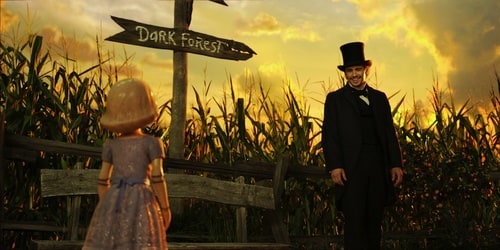For all of the flack it copped from critics, 2006's Silent Hill remains one of the most successful game-to-film translations to date. That may not be saying much, but it is a solid effort, a visually arresting horror flick supported by slick production values, believable acting, a bone-chilling sense of atmosphere, and competent direction by French director Christophe Gans. It left room for a sequel, which arrives six years after its predecessor. Considering that four Paranormal Activity movies and five Saw movies were released in the interim, such a gap is an eternity in the horror franchise world, making a Silent Hill sequel feel instantly outdated. It does not help that 2012's Silent Hill: Revelation is flaccid and forgettable, with a reduced budget and less directorial skill squandering the potential for a chilling exercise in terror.

Following the events of the original film, Rose (Radha Mitchell) manages to temporarily break the curse of Silent Hill, allowing her to return her daughter, Sharon (Adelaide Clemens), to the land of the living. To escape the demonic cult that rules the ghost town, Sharon's father, Christopher (Sean Bean), frequently moves the pair from state to state, never remaining in one place for very long and never retaining the same name. Now eighteen, Sharon is continually haunted by horrific nightmares of Silent Hill, which eventually begin to invade her waking hours. When Christopher is abducted, a note in blood is left on the wall asking for Sharon to return to the doomed township. Finding a friend in classmate Vincent (Kit Harington), Sharon makes her way back to Silent Hill to save her father, compelling the pair to brave the terrors within and hopefully neutralise the power of sinister witch Alessa.
Once Sharon and Vincent reach Silent Hill, the picture begins throwing out ridiculous videogame elements, including big boss fights, helpful bystanders, and the need to collect the other piece of an amulet. It's absurd stuff, and it struggles to frighten or even function on any effective level. The plot is complete nonsense, with writer-director M.J. Bassett simply incorporating pieces of gaming detail and familiar supporting characters for the fans. Furthermore, the mythology remains half-hearted and muddled, to the extent that one must wonder if anyone actually read the script before the cameras rolled. The characters attempt to explain everything through laborious passages of exposition that rely on telling rather than showing, but certain things still fail to make sense, and everything sounds exceedingly pedestrian. The biggest flaw of the first Silent Hill was its risible dialogue, even though it was penned by Roger Avary (who contributed to True Romance and Pulp Fiction). Revelation's script is worse, however, with the script containing goofball passages of dialogue and clichéd faux-intense horror movie speak ("You okay?", "Let's go!", and so on).

Revelation looks disappointingly cheap, even despite the polish of the 3D photography. Gans was working on a much more generous $50 million for the original picture, whereas Bassett has $20 million to play with, and the results are pale. A few set pieces here and there admittedly work, including a creepy sequence involving a spider-like creature and most of the scenes with Pyramid Head. Outside of this, Bassett does very little right, and the digital effects are too obvious. Budget constraints clearly forbid Bassett from mounting an intense, cohesive two-hour picture like its predecessor. Instead, the ride is ninety minutes, hence it feels somewhat disjointed and choppy despite the straightforward narrative, not to mention dramatically underdeveloped. The budget cuts may be understandable considering the first film's average box office performance, but no sequel at all is preferable to a sequel made on the cheap, which tarnishes the franchise name.
A few old faces return for duty here, with Bean reprising his role as Christopher and Mitchell popping in to play Rose in a tiny cameo. Bafflingly, Bean's performance is terrible here; he appears to be attempting an American accent, but it's appalling and inconsistent, and it honestly sounds as if the Brit native has been dubbed. Furthering the reunion are Roberto Campanella as Pyramid Head, and Deborah Kara Unger, who achieves precisely nothing as Alessa's mother. For whatever reason, Jodelle Ferland was jettisoned for the sequel, with Clemens stepping in to replace her as Sharon. An Australian native, Clemens is a dead ringer for Michelle Williams, and she's strictly okay in her role. The same cannot be said for Harington, a stiff actor who's never quite convincing enough. Also showing up is Carrie-Anne Moss, who honestly looks as if she doesn't know what's going on (join the club), as well as Malcolm McDowell, who must've been blackmailed into doing this thankless role.

If nothing else, one must credit both Silent Hill pictures for remaining true to their source. The first film does an impeccable job of capturing the game's eerie, hallucinogenic world, and this sequel at least tries to achieve something similar. That's more than can be said for Paul W.S. Anderson's Resident Evil film franchise, which ignores the horror-oriented games to showcase random slow-motion gunfire and bloodshed. However, this will probably just cause gamers to lament this missed opportunity of a sequel. It seems too late to salvage the film series at this point in time, with Revelation a total bust and with so many years having passed since Gans' extraordinary original effort. Revelation leaves room open for another sequel, but it's doubtful it will ever happen.
3.2/10
 Login
Login
 Home
Home 183 Lists
183 Lists 1674 Reviews
1674 Reviews Collections
Collections
 0 comments,
0 comments, 
































